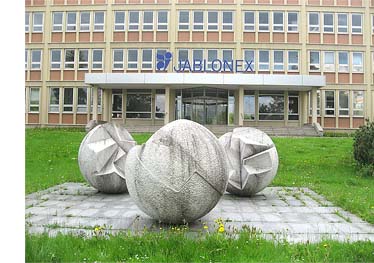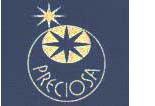|
The Czech Glass Bead: Who's
Making It?
Czech glass beads are probably the best in the world, and
have been for centuries. But the Czech Republic hasn't been around
for centuries, nor has Jablonex, or Preciosa. So who makes these
glass beads, and the glass, and who is bringing them to market?
And why Czech Republic? Why not Italy, or Germany, or the Middle
East?
The answer can be traced through history from many sources;
but basically glass was invented in the Middle East, in ancient
places such as Babylon, and Phoenicia, by ancient Jews or Hebrews
who gained a reputation as the best glassmakers in the world.
Glass centers were formed in principle cities for ease of trade,
and Venice, Italy became one such city. For centuries, glass
guilds attempted to keep the secret of glass making in its own
control, to keep others from making this special product. However,
by the 8th century, glass manufacturing had emerged in Germany,
along the Rhine river.
By the 14th century, King Charles of Bohemia had invited German
glassmakers to relocate to his kingdom of Bohemia to establish
a glass industry. He could offer unlimited sand, water and trees
needed for glass production. All over the Bohemian mountains
small towns grew with glass works the center of the life of the
village. Jablonec nad Nisou was one such town, having been established
in 1356.
Glass making flourished, and along with it new products such
as vases, stained glass windows, wound beads (also called lampwork
beads) and buttons. The first button mold for pressing glass
buttons was invented in 1732, and the first glass bead mold in
1832. New technologies such as machine cutting for crystal beads
was invented by Swarovski, who moved away from Jablonec in 1890
and then to Wattens, Austria to avoid industrial spying. In the
19th century, the Riedhl family controlled the glassworks in
the region around Jablonec, producing all the glass for all the
manufacture of beads and buttons. By the end of the Austrian
Empire there were over 2000 agents and exporters of the world
famous Bohemian glass in Jablonec. At that time, the town was
known as Gablonz nas Niesse, and control of the glass, glass
bead and button, and crystal vase/sculpture industry was firmly
in the hands of German industrialists.
By the end of World War 1 and the break up of the Austrian
Empire, Czechoslovakia came into being. Gablonz became Jablonec
nad Nisou, and glass production continued unabated. It slowed
during World War 11, and after the expulsion of most of the Germans
after the war was reduced to a mere shadow of its glorious past.
Only one company could export the glass products from the region,
and that was the State run Jablonex. There were still large factories
producing glass, such as Jizerske sklo, and Preciosa, who made
their own glass to support their crystal chandelier production,
 as well as many
small cottage industry factories making glass beads and buttons,
but all sales had to go through Jablonex. During the cold war,
the Czechoslovakian secret police ran spies to the west through
this company, and slave labor in the prison camps were forced
to make beads also, thereby keeping costs down so as to compete
with other glass companies outside of Czechoslovakia, such as
in Neu Gablonz, Germany, where most of the expelled German bead
makers settled, as well as Swarovski in Austria. as well as many
small cottage industry factories making glass beads and buttons,
but all sales had to go through Jablonex. During the cold war,
the Czechoslovakian secret police ran spies to the west through
this company, and slave labor in the prison camps were forced
to make beads also, thereby keeping costs down so as to compete
with other glass companies outside of Czechoslovakia, such as
in Neu Gablonz, Germany, where most of the expelled German bead
makers settled, as well as Swarovski in Austria.
Jablonex was state run, and very huge. During the communist
era, it became bloated with hundreds of employees, if not thousands.
Nothing could be produced and sold outside Czechoslovakia without
first going through Jablonex. Driving around Jablonec nad Nisou
today you will see many large, sprawling empty and deserted buildings
in 4 or 5 villages around the area belonging to Jablonex.
In 1989 things started to change. The Velvet Revolution happened,
and communism ended. Czechoslovakia gained its independence and
split into two countries - Czech Republic and Slovakia.
 Jablonex lost its monopoly in
being able to control the glass industry, and other large glass
companies such as Preciosa could now export its products to the
rest of the world. So could smaller glass beadmakers who in the
past could make their exclusive beads but only market them through
Jablonex and its traveling salesmen; now they could sell directly
to any customer who found them and export directly to any country
they wanted. Jablonex lost its monopoly in
being able to control the glass industry, and other large glass
companies such as Preciosa could now export its products to the
rest of the world. So could smaller glass beadmakers who in the
past could make their exclusive beads but only market them through
Jablonex and its traveling salesmen; now they could sell directly
to any customer who found them and export directly to any country
they wanted.
By 2000, there were over 60 agents and exporters listed in
the phone book in Jablonec, and growing. Also during this time
Jablonex was buying up businesses. They purchased the last independent
glassworks factory in Jablonec; Jizerske Sklo. Jablonex now controlled
what glass could be made, when it would be made, and for how
much it could be sold. They also purchased Ornela, the last seed
bead factory in Europe. Sounds like a monopoly again. Also during
this time frame Swarovski held a 24% interest in Jablonex, and
had two members on the board of directors. It was thought that
Swarovski was attempting to gain control of the glass bead industry
by taking over Jablonex and thereby imprinting its name on the
glass industry as the best beads in the world.
But, small cracks were beginning to develop in Jablonex foundation
around this time. Managers of different divisions within Jablonex
were either being fired or were quitting to start their own bead
businesses. The economic crisis was being felt early on in Jablonex,
as sales were falling dramatically to competition that was rising
around them. Jablonex still was adhering to their distributor
philosophy, and would not bring in new buyers. Finally they did,
with Fire Mountain Gems. But it was too late for Jablonex to
catch up. Desperate measures were taken. Zelezeny Brodske Sklo
was closed, and everybody laid off. (They produced most of Jablonex
fire polish beads and chandelier parts). Another was Glass SRO,
who lost its exclusive contract with Jablonex, and closed due
to lack of other business being able to keep it alive. (They
supplied many pressed beads for Jablonex). More and more managers
left the sinking ship to start their own businesses.
In 2008, Jablonex folded. Everybody was laid off, and buildings
closed down and became vacant. The business was up for sale.
Later that year, Preciosa announced the purchase of Jablonex.
They weren't in a hurry, as there was a lot to clean up. Most
of the buildings are still vacant, with "for Sale"
signs posted on them.
By 2010, Jablonex was in the last month of closing down its
flagship retail store "Jablonex Palace" based in its
corporate headquarters building. A month later, it reopened as
"Preciosa Palace" in the same location. Nothing looked
different.
Preciosa now controls the largest glassworks and bead business
in Czech Republic, under the new corporate name of Preciosa Ornela.
Preciosa used to make crystal chandeliers. Now they make crystal
machine cut beads under the name Preciosa; glass beads under
the name Preciosa, but also using the advertising name and logo
Jablonex - Traditional Czech Glass Beads.
They still buy their beads from the hundreds of small cottage
industry bead and button makers from around the region, and we
feel they are still the best glass beads in the world.
So now if someone asks the question, you know the answer.
==========================================================================
J-Me and Guy are the owners of Wild Things, a small family
run import and bead tour business located deep in the foothills
of the Sierra Nevada mountains of Northern California. They can
be reached by phone at (530) 743 1339 or on the web at www.wildthingsbeads.com
   |